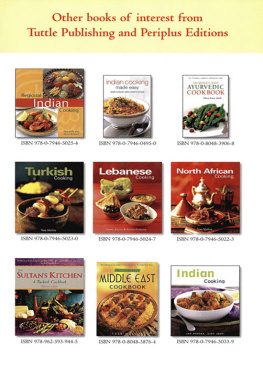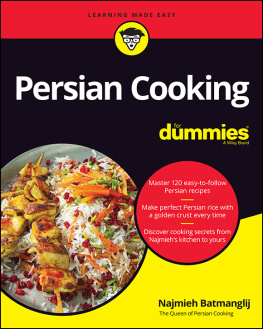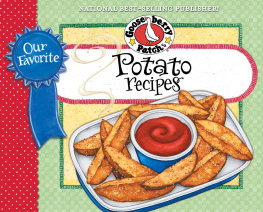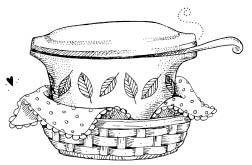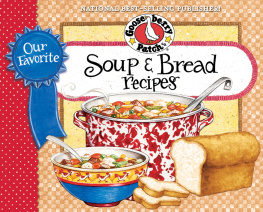Acknowledgments
This book had its beginning several years ago when two of my very dear college friends, Joanie Rush and Martin Stow, persuaded me to write down the recipes for the many Persian dishes I had cooked for them. Joanie, a very practical American housewife, was anxious to find short cuts for the more elaborate recipes. She wanted my recipes to be economical, easy to prepare, and still retain their exotic qualities. On the other hand, Martin, a gourmet in his own right, insisted that the recipes be kept as authentic as possible. Indeed without this sort of balance which my two friends provided I would have been unable to make these recipes authentic and yet practical.
While writing a first book, the assistance and encouragement of friends are most welcome. Among my friends who have graciously sampled my recipes, I would like to express my appreciation to Marianne Mandel for her culinary advice and to Frank Dines, a connoisseur of foreign foods and an excellent artist, for his kind advice concerning the design and illustrations of the book. Thanks are also due Dr. and Mrs. H. A. Esfandiary, who generously made available a variety of reproductions of Persian art work from which many of the designs were taken.
In writing this book I was anxious to make the accompanying stories colorful and interesting. Since English is not my native language, there were times when I could not express myself perfectly, and I would like to thank my husband, Charles Magee, for his enthusiasm, understanding, and excellent editing.
Finally I want to thank my mother, who has been so patient in testing every recipe with me and who has advised and guided me step by step. I would also like to thank Maryam Mehran and my many friends, Persian and American, for encouraging me and for being gracious guests while I tried out every recipe on them.
I have enjoyed many delightful hours while perfecting these recipes. Now the finished product is yours. Try these dishes, and I do hope that you enjoy them. As we say in Persian, "Nushe Janetan Bashad," or bon apptit.
MAIDEH MAZDA
Appendix
Persian Uses and Descriptions of Herbs, Spices, and Unusual Ingredients
ALLSPICE: A spice used with meats, sauces, stuffings, etc.
BAY LEAVES : May be used in soups, stews, poultry, etc.
BAKLAVA PASTRY : Very thin layers of dough which may be purchased in Greek or Armenian bakeries and groceries.
CARDAMOM SEEDS AND POWDER : Used in baking pastry or desserts. May be purchased in large groceries or specialty stores.
CINNAMON STICKS AND POWDER : A spice often used in seasoning meats and poultry and in baking pastry and in desserts.
CURRY POWDER : Used to season meats, eggs, poultry, and sauces made with yogurt.
DILL : The Persians use a great deal of fresh dill with rice, meat, salads, soups, and yogurt. Dill weed may be substituted when fresh dill isn't available. Fresh dill may be purchased in Greek, Armenian, or Italian groceries.
GARLIC : Used for meats, salads, soups, and some sauces.
GOAT'S CHEESE : White cheese, which in Persian is called panir. Used in salads or appetizers with fresh mint or tarragon. May be purchased in Greek or Armenian stores under the name feta.
GRAPE LEAVES : Grape leaves are used for Dolmeh, or stuffed grape leaves. Preserved grape leaves may be purchased in Greek or Armenian stores.
MINT : Mint, fresh or dry, is much used by the Persians. Fresh mint is used in drinks and salads, and dry mint in combination with cinnamon and black pepper is used in seasoning soups, sauces, etc.
NUTMEG : May be used in seasoning lamb, meats, sauces, vegetables, and pastries.
OREGANO : May be used in seasoning lamb, meats, stews, and salads.
PAPRIKA : Used for soups, meats, salads, salad dressings, and garnishings.
POMEGRANATE SYRUP : Used in preparing khoreshes and sauces. May be purchased in Greek or Armenian stores.
POULTRY SEASONING : Used in seasoning game and poultry.
RICE : For Persian polo or chelo long-grain white rice should be used. Brands such as "North Carolina" long grain or "Show Boat" give very good results.
ROSE WATER : Rose water is used in desserts, pastries, and drinks. It can be purchased in Greek or Armenian groceries.
SAFFRON : Often used in seasoning rice, lamb, sauces, and pastry. Saffron may be purchased in any large grocery store or at Greek or Armenian stores. If you use "Spice Island" powdered saffron, follow the directions given, and for seasoning Persian dishes use a tablespoon or two of the saffron which has been dissolved in water according to the directions.
SUMAC : Sumac is a spice which looks like chili powder and has a somewhat sour taste. It is used with meats, especially broiled meats such as kabab or steaks. May be purchased in Armenian or Greek groceries.
TARRAGON : In Persia fresh tarragon is used extensively with meats, salads, cheese, etc. Since fresh tarragon is scarce in America, dry tarragon can be substituted and used in seasoning, stuffings, lamb, salads, and meats.
THYME : Used for seasoning game, poultry, lamb, stuffing, etc.
TURMERICK : Widely used in Persia for rice, meats, stews, and in baking.

Mast
Yogurt
Mst , known in America as yogurt, is used extensively in Persia and all the Middle Eastern and Balkan countries. Many scientists of today attribute the stamina and longevity of the Middle Eastern and Balkan people to mst. These people are practically immune to ulcers and other stomach ailments. Yet they are among the poorest people in the world and their daily food lacks the vitamins necessary for good health. Yogurt is considered the panacea for human ills, and the Persians' long life is attributed to it.
Mst, which is now becoming more popular in the Western world, has been known to the Middle Easterners for centuries by different names. The most popular name for mast is yogurt. In the Balkan countries, Turkey, and in the West you can buy mast under the name of yogurt. In North Africa and in the Arabic-speaking countries it is known as leban. Armenians call it madzoon , and the Mongols for centuries have called it koumis. It is said that Genghis Khan lived on it during his long marches through Mongolia and the Persian Empire when he couldn't obtain other food.
In Iran, yogurt is the food of the rich as well as the poor. Walking down the avenue at lunch hour in Tehran, you will see the mason, the cobbler, the carpenter, the storekeeper, all using yogurt as their daily food. If you go into a restaurant, you will find yogurt served there in many forms.
A Persian housewife whose ancestors have had this "health food" for generations finds many uses for it. She serves yogurt with meals, makes very delicious warm or cold soup with it, or serves it as a dessert.
For generations the Persians have served yogurt as a soft drink in summer. They dilute it with water, add a pinch of salt, and call it abdug. The Iranian housewife keeps abdug on hand and serves it to her family and guests on hot summer days. This drink has served as a perfect substitute for "salt tablets."
In Tehran and other cities of Iran vendors who sell abdug on street corners are familiar sights. Very often they advertise their products with a poem or two from Omar Khayyam and replace Omar's "jug of wine" with a "jug of abdug."

